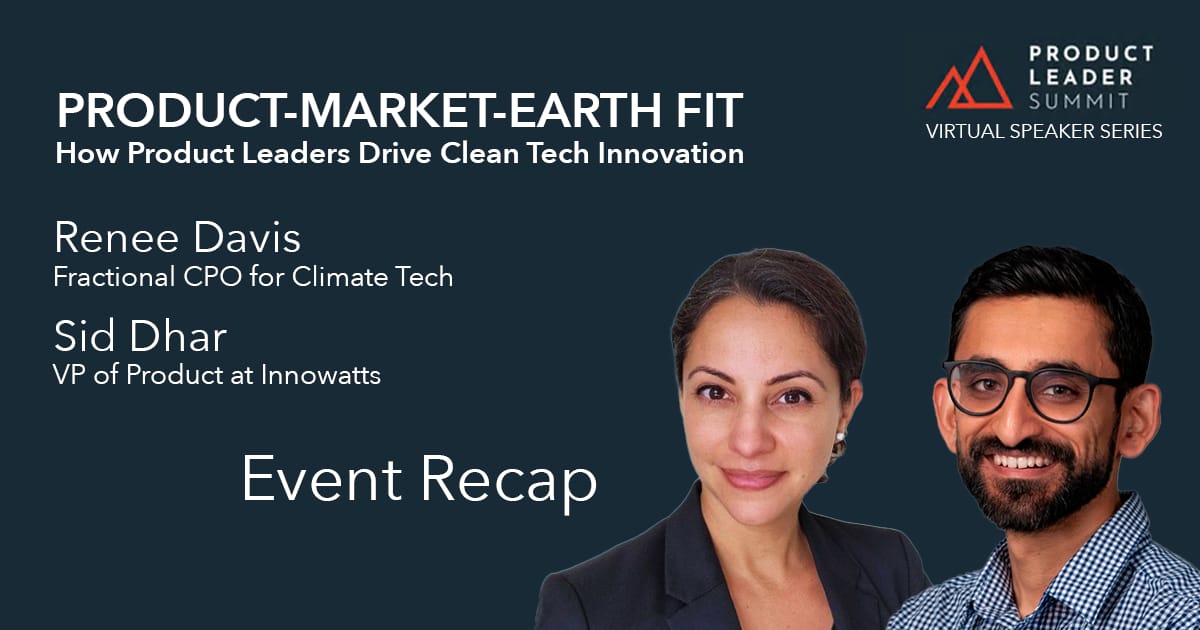- Product Leader Summit Speaker Series
- Posts
- Event Recap: Beyond Product-Market Fit: Innovating Within Planetary Boundaries
Event Recap: Beyond Product-Market Fit: Innovating Within Planetary Boundaries
On Friday, March 7th, we heard from Renee Davis, who joined moderator Sid Dhar for a thought-provoking conversation on how product leaders can drive clean tech innovation while staying within planetary boundaries — Missed the session? Here’s what you need to know!
Clean tech is no longer a niche—it’s a necessity. But how can product leaders drive meaningful innovation in this space while balancing sustainability, scalability, and market demands?
In this Product Leader Summit Virtual Speaker Series session, Renee Davis shared her hard-won insights on navigating the unique challenges of clean tech product development. From overcoming regulatory hurdles to aligning climate impact with business goals, this discussion provided actionable frameworks for product leaders shaping the future of sustainable technology.
Read the recap below, watch the recording and view the deck!

🌱 From Product-Market Fit to Product-Market-Earth Fit
Renee shared her personal journey of aligning her career purpose with her passion for sustainability, leading to the development of the Product-Market-Earth Fit framework. Traditionally, product-market fit focuses solely on customer needs and business value. Renee urged attendees to rethink this by including the Earth’s needs in the equation. In other words, it’s time to build products that not only delight customers and meet business goals but also minimize environmental harm.
🌿 Why This Matters Now
The session provided a sobering look at the tech industry’s role in contributing to climate change, noting that the sector produces over 1.3 billion tons of CO2 emissions annually and is projected to grow by 300% by 2040—largely driven by AI.
Renee stressed that as product leaders sitting at the intersection of technology, business, and customer experience, we have outsized influence over how resources are used, and how sustainable behaviors are promoted through our products.
🛠 The EARTH Framework
Renee introduced the EARTH framework, a practical tool product leaders can use to integrate environmental impact thinking at every stage of product development:
E: Energy
A: Actions
R: Resources
T: Total Impact
H: Habits
For a bite-sized version, you can start from EAT: Energy, Actions and Total Impact. “EATing your emissions for breakfast”
Energy—how much energy does your product consume?
Actions—what user behaviors are you encouraging and how can defaults nudge users toward lower-emission actions?
Total Impact—are you tracking your product’s environmental footprint alongside traditional KPIs?
🧩 Nudges in Action: The Power of Defaults
Renee shared inspiring case studies showing how subtle changes in product design can drive massive environmental outcomes:
• Netflix defaulted EU users to standard definition streaming during the pandemic, reducing energy consumption by up to 90% compared to 4K.
• Uber & Lyft promoted ride-pooling options as default choices, leading to significant reductions in CO2 emissions.
• Nest smart thermostats automatically shift to energy-saving modes when homes are unoccupied, cutting household emissions by up to 24%.
🏆 Your Role as a Product Leader
The key takeaway: you don’t need to be in a climate-first company to make an impact. Every job can be a climate job. Whether you’re working in fintech, SaaS, or infrastructure-heavy clean tech, product leaders have an opportunity—and responsibility—to embed climate consciousness into product thinking.
💡 Closing Thoughts
Renee encouraged leaders to:
Broaden their resource stewardship to include Earth’s resources.
Shift from linear to circular systems thinking.
Leverage simple tools, like carbon footprint calculators from cloud providers, to begin measuring impact.
As climate challenges accelerate, adopting frameworks like Product-Market-Earth Fit isn’t just forward-thinking—it’s becoming essential. Renee closed with a call to action for product leaders to normalize sustainable practices and create products that benefit users, businesses, and the planet alike.